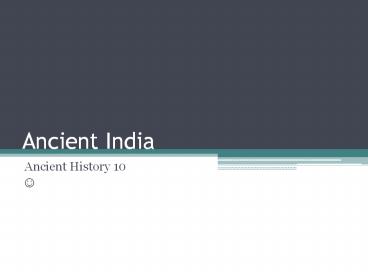Ancient India - PowerPoint PPT Presentation
1 / 14
Title: Ancient India
1
Ancient India
- Ancient History 10
- ?
2
Geography of Ancient India
3
Geography- Plate Tectonics
- India is entirely contained on the Indian Plate.
- A major tectonic plate that was formed when it
split off from the ancient continent
Gondwanaland. - About 90 million years ago, during the late
Cretaceous Period.
4
Geography regions
- India can be divided into six physiographic
regions. - The Himalayan Mountains
- Northern Plains
- The Great Indian Desert
- The Peninsular Plateau
- Coastal Plains
- Islands
5
Geography
- The river valleys of India were particularly
suited for the growth of the civilization because
they are wide, level and fertile. - Why is this important for the growth of a
civilization?
6
Geography Brainstorm
- What are some of the important aspects of having
a river in a valley? - Insert response here ?
- ha, ha, ha
- There is approx. 4 important features.
7
Geography
- The mountain ranges protected the civilization
from invaders, but they also slowed the growth of
the civilization as they make travel and trade
difficult. Trade introduces new products, ideas
and technologies to a region.
8
India Water ways
- India has around 14,500 km of inland navigable
waterways. - There are twelve rivers which are classified as
major rivers. - All major rivers of India originate from one of
the three main watersheds - The Himalaya and the Karakoram ranges
- Vindhya and Satpura range in central India
- Sahyadri or Western Ghats in western India
- The Himalayan river networks are snow-fed and
have a perennial supply throughout the year. - The other two river systems are dependent on the
monsoons and shrink into rivulets during the dry
season.
9
Geography
- The Indus River Valley was the home of Indias
1st great civilization, that is as old as
Mesopotamia. - On a piece of paper list some of the similarities
and differences between the geography of
Mesopotamia and India.
10
Mountains
- Himalayan range (Mt. Everest)
- Karakoram
- Patkai, or Purvanchal
- Vindhya range
- Satpura Range
- Western Ghats or Sahyadri mountains
- Aravali Range
- Eastern Ghats
11
Thar Desert
- Desert tribes living in the Thar Desert near
Jaisalmer, India. - The Thar Desert is the world's seventh largest
desert. - It forms a significant portion of western India
and covers an area of about 200,000 km2 The
desert continues into Pakistan as the Cholistan
Desert. Most of the Thar Desert is situated in
Rajasthan, covering 61 of its geographic area.
12
Thar Desert
- About 10 percent of this region comprises sand
dunes, and the remaining 90 percent consist of
rock forms, compacted salt-lake bottoms, and
inter-dunal and fixed dune areas. - Temperatures 0C in the winter to over 50C
during the summer. - Rainfall in this region is between
JulySeptember southwest monsoon that brings
around 100500 mm of precipitation. Water is
scarce and occurs at great depths, ranging from
30 to 120 m below the ground level.
13
Geography Comparison
- Mesopotamia/ Egypt
- India
14
Complete the Map of India HandoutWhat you
dont finish in class is for HOMEWORK.?































